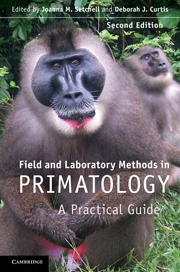Book contents
- Frontmatter
- Contents
- List of contributors
- Foreword by Robert D. Martin
- Introduction
- 1 An ethnoprimatological approach to interactions between human and non-human primates
- 2 Habituating primates: processes, techniques, variables and ethics
- 3 Habitat description and phenology
- 4 Geographical information systems and remote sensing
- 5 Monitoring local weather and climate
- 6 Survey and census methods: population distribution and density
- 7 Trapping primates
- 8 Handling, anaesthesia, health evaluation and biological sampling
- 9 Morphology, morphometrics and taxonomy
- 10 Marking and radio-tracking primates
- 11 Field experiments with non-human primates: a tutorial
- 12 Feeding ecology, frugivory and seed dispersal
- 13 Dietary analysis I: food physics
- 14 Dietary analysis II: food chemistry
- 15 Collecting arthropods and arthropod remains for primate studies
- 16 Recording primate vocalizations
- 17 Photography and video for field researchers
- 18 Chronobiological aspects of primate research
- 19 Thermoregulation and energetics
- 20 Field endocrinology: monitoring hormonal changes in free-ranging primates
- 21 Collection, storage and analysis of non-invasive genetic material in primate biology
- 22 Tips from the bush: an A–Z of suggestions for successful fieldwork
- Index
- References
10 - Marking and radio-tracking primates
Published online by Cambridge University Press: 05 June 2012
- Frontmatter
- Contents
- List of contributors
- Foreword by Robert D. Martin
- Introduction
- 1 An ethnoprimatological approach to interactions between human and non-human primates
- 2 Habituating primates: processes, techniques, variables and ethics
- 3 Habitat description and phenology
- 4 Geographical information systems and remote sensing
- 5 Monitoring local weather and climate
- 6 Survey and census methods: population distribution and density
- 7 Trapping primates
- 8 Handling, anaesthesia, health evaluation and biological sampling
- 9 Morphology, morphometrics and taxonomy
- 10 Marking and radio-tracking primates
- 11 Field experiments with non-human primates: a tutorial
- 12 Feeding ecology, frugivory and seed dispersal
- 13 Dietary analysis I: food physics
- 14 Dietary analysis II: food chemistry
- 15 Collecting arthropods and arthropod remains for primate studies
- 16 Recording primate vocalizations
- 17 Photography and video for field researchers
- 18 Chronobiological aspects of primate research
- 19 Thermoregulation and energetics
- 20 Field endocrinology: monitoring hormonal changes in free-ranging primates
- 21 Collection, storage and analysis of non-invasive genetic material in primate biology
- 22 Tips from the bush: an A–Z of suggestions for successful fieldwork
- Index
- References
Summary
INTRODUCTION
Although the past two decades have seen a revolution in many aspects of field biology due to advances in radio-tracking and telemetry, including the development of satellite and GPS technology, these techniques have been less applied to primates than to other orders of mammals or to vertebrates in general (Casperd, 1992). A comprehensive account of animal tagging and radio-tagging would warrant a book in itself, but here we aim to draw the attention of primatologists to the advances in this family of techniques. We review a number of important studies of primates that have used them, and introduce the practicalities involved. If you are considering the use of these techniques then you should advance no further without exploring the wider, and vast, literature associated with radio-tracking other mammals. General reviews of radio-tracking are presented in Amlaner and Macdonald (1980), Kenward (2001), Millspaugh and Marzluff (2001) and Telonics Quarterly (see ‘List of supplies and useful Internet sites’).
The term ‘radio-tracking’ is correctly applied only to the use of radio transmitters and receivers to record location information. Traditionally, most field biologists have used VHF (Very High Frequency) or UHF (Ultra High Frequency) radio-tracking transmitters, but recently there has been a rapid growth in satellite tracking systems and associated technology (Chapter 4). ‘Biotelemetry’ is, strictly, the remote measurement of biological, particularly physiological, data (e.g. heart rate, blood pressure, body temperature, brain wave activity) (Amlaner, 1978; Chapter 19).
- Type
- Chapter
- Information
- Field and Laboratory Methods in PrimatologyA Practical Guide, pp. 189 - 206Publisher: Cambridge University PressPrint publication year: 2011
References
- 5
- Cited by

